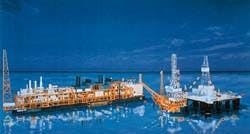- Nkossa Setting [38517 bytes]
- Nkossa Field Facilities Layout [162516 bytes]
A large floating production unit (FPU) was last reported under tow to Nkossa oil and gas field, being developed off Congo by Elf Aquitaine and partners.
The 220 m long by 45 m wide prestressed concrete barge, billed as the world's biggest FPU, is on a 6 week journey from its construction site at Fos-sur-Mer on the French Riviera. It will be linked to two unmanned wellhead platforms and two floating storage/offloading (FSO) tankers at its installation site.
Nkossa production is to start in mid-1996 at 30,000 b/d of oil, build to 100,000 b/d in 2 years, and plateau at 120,000 b/d and 1,300 metric tons/day of liquefied petroleum gas.
The FPU accounts for half of Nkossa field development costs estimated at a total 9.5 billion francs ($1.9 billion).
Elf estimates the floating barge concept has saved it almost $200 million compared with a traditional production system and will result in considerable added savings on maintenance (OGJ, Nov. 27, 1995, p. 31).
It hopes to apply the technology to deepwater development projects that may result from Elf's exploration efforts in about 1,000 m of water in the Gulf of Guinea off Angola, Congo, and Nigeria.
Operator Elf Congo, a 75-25 venture of Elf and the Congo government, holds a 51% interest in Nkossa field and the Haute Mer concession. Its partners are Chevron Overseas Congo Ltd. 30%, state owned Hydrocongo 15%, and Engen Exploration (Congo) Ltd. 4%.
Chevron is appraising a sizable oil discovery it made on the Haute Mer concession last year, only 9 miles west of Nkossa (OGJ, Nov. 20, 1995, p. 40).
Artist's rendering of Nkossa field facilities shows floating production barge (below) linked to one of the field's two wellhead platforms. At far right is a semisubmersible rig drilling development wells under a tender assisted operation. Not shown is a second wellhead platform and semisubmersible drilling rig and two floating storage/offloading tankers-one dedicated to crude oil, the other to liquefied petroleum gas. Image courtesy of Elf Aquitaine.
Facilities details
The Nkossa FPU will be installed in 170 m of water linked to the two drilling platforms 3,200 m apart.
The FPU weighs 70,000 metric tons, including 30,000 tons for topsides. Deck surface is about 10,000 sq m.
Each wellhead platform is designed to support 32 wells. Development wells will be drilled by semisubmersible rigs under a tender assisted operation, with all oil and gas processed on the concrete barge.
One of the FSO tankers can store 270,000 metric tons of crude oil, the other 80,000 cu m of LPG.
The FPU contains six modules: accommodation and central control, utilities, electric power generation, gas compression for reinjection, crude oil and gas treating/separation, and LPG. The accommodation unit can support 160 persons.
The modules were integrated with the barge hull onshore in France to save money compared with offshore construction. The final assembled FPU is being shipped to Congo for quick installation to the FSOs and wellhead platforms via flexible flow lines.
Development details
Predrilling of Nkossa wells is under way, with installation of the two wellhead platforms slated for last month and this month, to be followed by barge installation.
The Nkossa reservoir is at 3,000 m in water depths of 150-300 m. It is eliptically shaped with 400 m of gross pay. Oil gravities range from 38 at bottom to 40 at top.
Nkossa crude will be sold at a premium over the North Sea Brent blend benchmark. Because of the high quality of the crude, Elf chose the offshore treating/storage/offloading scheme rather than transporting Nkossa oil to onshore treating facilities at Djeno, where heavier crude is handled.
The reservoir has a high gas:oil ratio, requiring simultaneous water and gas injection to sustain reservoir pressure after gas is produced.
Gas will be treated and reinjected at a rate of 350 MMcfd through five horizontal wells, resulting ultimately in a large, undeveloped gas field off Congo.
Development costs break out as 40% for the FPU, 30% for drilling and completion, 20% for the wellhead platforms and FSOs, and the remainder for miscellaneous costs. Field life is estimated at 25-30 years.
Following Elf's discovery of Nkossa on the Haute Mer permit in 1984, the company drilled two appraisal wells and conducted a 3D seismic survey in 1989-91. The development decision came in December 1992.
Copyright 1996 Oil & Gas Journal. All Rights Reserved.

